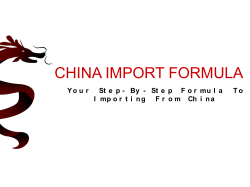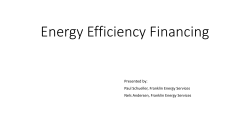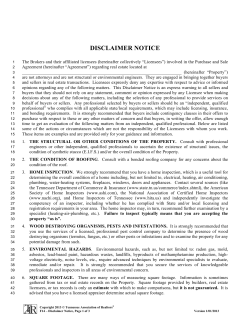
How to Create a More Competitive End-to-End Supply Chain first
first quartile How to Create a More Competitive End-to-End Supply Chain Supply-chain finance (SCF) is emerging as the next frontier that manufacturers and retailers are focusing on to drive financial advantage over their competitors. Supply-chain finance (SCF) is emerging as the next frontier that manufacturers and retailers are focusing on to drive financial advantage over their competitors. Early adopters report dramatic improvements in days payable outstanding (DPOs), supply-chain cost of capital and cost of goods sold. By merging physical supply-chain information with financial supply-chain data and flexible funding methods, companies are able to not only automate payables and receivables but also to inject much-needed liquidity at various stages of the supply chain. For a supplier, this can mean faster access to lower-cost capital. For a buyer, it can mean the ability to: Optimize working capital by reducing inventory ownership and improving A/P and A/R balances. Reduce product unit costs by taking advantage of arbitrage opportunities due to a higher cost of capital for many suppliers (e.g., offering suppliers access to third-party capital at a lower rate in return for a Beth Enslow is senior vice president of enterprise research for Aberdeen Group, a leading business and IT benchmarking and advisory company. Enslow oversees Aberdeen’s supply chain finance research practice and has more than 15 years experience in helping companies improve their supply chain and corporate performance management. She also is a lecturer on supply chain finance at York University’s Schulich School of Business Executive Learning Center in Toronto. 48 business finance april 2007 By Beth Enslow lower cost of goods sold or by offering early payment discounts using a company’s own cash) Extend days payable outstanding (DPOs) by offering suppliers more visible and predictable payment. Companies that have improved end-to-end supply chains have enjoyed substantial benefits, such as being able to extend DPO by over 50 days, improve cash flow by hundreds of millions of dollars or decrease unit costs by 5 percent to 10 percent. Better Visibility Enabling LowerCost Funding Options A major departure from traditional trade-finance practices is the ability to leverage enhanced visibility into supply-chain and buyer information to more accurately assess transactional risk and thus be able to reduce the cost of capital and expand credit lines for sellers. By gaining better visibility into order and shipment status and historical performance (e.g., on-time delivery, order completeness), financial transactions between a supplier and buyer can be assessed, securitized and sold at a lower credit premium. The result can be an end-to-end reduction in the cost of goods sold. A variety of banks, other financial institutions and third-party supply-chain finance vendors are GLOBAL SUPPLY CHAIN: What’s On Your Wish List? Buyer Top Actions Planned for Next 18 Months Negotiate price reductions with suppliers for early payment Implement a scorecard system to track supplier performance Supplier Top Actions Planned for Next 18 Months Implement a solution that enables streamlined transaction processing/ document mgmt and access to financing Find a cheaper source of financing Implement new technology for better automation and visibility Implement new technology for better automation and visibility Extend payment terms Obtain additional financing from a financial institution Implement a solution that enables both streamlined transaction processing/ document mgmt and access to financing Use purchase order performance milestones to trigger buyer payment or export finance Key takeaway: Suppliers want improved access to financing Four out of the five top actions for suppliers are targeted at improving their access to financing. These results confirm that suppliers are usually more constrained in their access to financing and that mutually beneficial arrangements can be created if a buyer is willing to help suppliers solve their cash flow and credit challenges. creating new programs in these areas. These providers include HSBC, Citigroup, Bank of America, UPS Capital, InStream Financial, Orbian, Demica, PrimeRevenue, TradeCard, EZD Global, and SCF Capital. By leveraging better visibility and control over supply-chain transactions, today’s SCF options also enable financing to be done at many more points in the supply chain, such as raw materials, intermediate production, point of shipment, customs clearance and arrival at the vendor-managed inventory (VMI) hub. This helps unlock the trapped value of goods throughout their life cycle. This is particularly attractive to companies involved in low-costcountry sourcing. The Drawback of One-Sided DPO Programs Drawn by the same goals of improving workingcapital and cash-flow forecasting and lowering the cost of capital, buyers and suppliers nonetheless pursue conflicting actions to enhance their SCF practices. The actions that pose the lowest risk to buyers, such as extended-payment terms, have the highest risk for their suppliers, which often have constricted access to short-term financing and a much higher cost of money. Techniques such as payables extension or supplier-managed inventory programs transfer credit risk and capital costs up the supply chain — in effect, pushing them to their weakest point. Simple cost shifting to suppliers may result in a short-term balance-sheet benefit for a buyer but can boomerang in the form of a less financially stable — and thus higher-risk — supply base. Strapped for cash and lacking adequate access to affordable capital, suppliers may be forced to delay raw-material ordering, squeeze work-in-process inventories, or skimp on plant maintenance or quality processes. This can trigger downstream delays and quality issues for the buyer, including expensive manufacturing-line shutdowns, derailed store promotions or late orders for critical customers. The buyer may end up writing checks to suppliers and sending teams to their plants to keep the supply chain operating. To stay in business, suppliers are eventually forced to bury the cost of extended-payment terms or unpredictable payment in the cost of goods sold. This results in an overall higher cost of goods sold versus competitors that have mastered more advanced SCF practices. Best-in-class companies are much further along in creating a win-win arrangement that will foster a more competitive end-to-end supply chain that is cost- and risk-advantaged. They are leveraging innovations from supply-chain finance specialists and financial institutions to lower the overall 49 april 2007 business finance first quartile Best-In-Class Buyers Show Better Performance Best-In-Class Industry AverageLaggards Total Best-In-Class Advantage Average DPO (Days Payable Outstanding) 58 49 44 13.6 Days Rate at which buyers obtain trade financing (Annualized %) 8.2% 10% 12.9% 2.86% source: aberdeen group weighted cost of capital for their end-to-end supply chain. These early adopters are proving that a company can revise its financing and payment terms without bringing noticeable disruptions to its own organization, while at the same time releasing the trapped value in the order-to-pay cycle and realizing increased savings on goods procured. What Best-in-Class Companies Do Differently To gain an understanding of current supply-chain finance practices and emerging trends, Aberdeen Group recently conducted two studies over a total of 253 companies. The study results show that 13 percent of companies are actively using supply-chain finance innovations today to create a more competitive end-to-end supply chain. Moreover, 56 percent of companies report that they are currently investigating options or planning activities in supply-chain finance. Both large and midsize companies are finding that they can take advantage of these innovations. About 20 percent of companies studied showed improvements over the past two years in DPOs for buyers or days sales outstanding (DSOs) for Supply chain finance in Action Reducing End-To-End Supply Chain Costs A JT, a fast-fashion retailer with 90 stores in the United Kingdom and Ireland, has adopted a solution from supply-chain finance provider EZD Global to create cost advantages for itself and its suppliers. “We were looking to maximize our margins, but we also wanted to cultivate better trading-partner relationships,” explains Richard Clark, AJT’s finance director. “In the fastfashion market, we often have to request quick turnaround from our Asian vendors, so we need them to view us as a valued customer.” According to AJT, its suppliers used to go to their local banks and get an advance on the money from the letters of credit. This would get them their cash faster, but they could lose as much as 20 percent of the value of the purchase order by doing this. “We now invite our clothing vendors to use EZD Global’s supply-chain finance service, which enables them to get paid 70 percent when the container leaves their 50 business finance april 2007 shipping dock and 30 percent at some later point, such as receipt at our warehouse,” says Clark. “Using the supplychain finance service, the suppliers gain back 5 percent to 15 percent of the purchase-order value they were losing. We share in the savings by getting 5 percent to 10 percent more off of our unit costs. However, we want our vendors to have an improvement in their bottom lines — we are not looking to have all the savings passed on to us.” To make the process work, AJT sends information from its supply-chain transactions to EZD Global so that the provider can more accurately assess the financial risk on an on-going basis. This translation of supply-chain risk into financial risk also has been beneficial for AJT. “The assessment data has been an unexpected benefit,” says Clark. “It has given us a better view of our supply-chain base and its strengths and weaknesses — for instance, can a vendor actually supply goods in the volume, quality and speed you need?” first quartile suppliers as well as in the rate at which trade financing is obtained. These are considered best-in-class companies. Some 44 percent of companies improved in only one of these metrics and are considered industry average, and 36 percent of companies saw no improvement or deterioration in these metrics and are considered laggards. As the Best-in-Class Buyers Show Better Performance table on page 50 shows, best-in-class companies have substantially better DPOs and trade-financing rates than their peers. Moreover, the average cost of short-term capital (annualized percentage) is at least 2.9 percentage points lower for best-in-class and industry-average companies than it is for laggards. The best in class are found across all revenue sizes and industries, including retail, pharmaceuticals, consumer goods, indus- Know Your Partner Understanding the challenges faced by one’s trading partners can help improve the relationship and negotiate more beneficial contract and financing terms for both parties. For Buyers Cash-flow uncertainty is the key working-capital management challenge for suppliers. This should lead buyers to increase their efforts to improve communication regarding payments and make payment timing more consistent in order to help suppliers better forecast cash flows. Keep in mind that when you pay small suppliers late, causing them to delay payments to their creditors, this will result not only in higher costs for their business credit, but also for their personal credit, such as higher car-insurance premiums for their family car. Fully 39 percent of suppliers say that a top issue for them is their inability to access financing at acceptable terms. This should trigger discussions of potential supply-chain finance arrangements where suppliers can obtain less-expensive financing from a third party. Buyer-funded early-payment discount programs can also help. For suppliers Understand that buyers are predominantly concerned with improving their working capital and lowering the cost of goods sold. Suppliers should more clearly communicate to their customers the possibilities of lowering product costs if buyers agree to improve other aspects of their current supply-chain finance arrangement. This could include adopting a common visibility-enhancing technology platform, extending pre-export financing for more dynamic production, or taking on responsibility for buying the raw materials consumed by the supplier. For both parties Understand that the high costs and long processing times of manual-intensive financial-transaction processing and trade-document management are a concern for both sides. Implementing a new technology platform that provides a single version of payment truth could reduce processing costs and greatly increase transaction and spend visibility for both parties. 52 business finance april 2007 trial equipment, automotive, aerospace, chemicals and paper. So what’s enabling best-in-class companies to achieve greater improvements in supply-chain finance metrics than their peers, as well as better absolute results? Best-in-class companies are: More than three times as likely to use an electronic invoice presentment and payment (EIPP) system as laggards Three times more likely to use an online payment platform with automated-discounting and invoicereconciliation capabilities Twice as likely as their peers to extend payment terms and participate in or run an early-payment discount program More actively involved in using supply-chain financing techniques than their peers and are more likely to be planning to take advantage of new funding opportunities and innovations in the next 18 months Technology and the Buyer/Seller “Win-Win” Is there a correlation between technology and SCF effectiveness? Best-in-class buyers and suppliers have a significant lead over their peers in using supply chain finance-enabling technology. Tellingly, more than half of industry-average companies say they plan to implement new technology for better automation and visibility in the next 18 months. The key to best-in-class companies’ success is that they have taken an automation and funding approach that lets them achieve extended-payment terms while providing benefits back to the supplier. Interestingly, an automated treasury and cashmanagement platform did not have any correlation with better performance, while externally facing automation such as EIPP and advanced online payment platforms did. Best-in-class companies were also more than twice as likely as laggards to use an automated bank-account management platform. This suggests that companies would be better served investing in new externally facing supply-chain finance technology versus upgrading internal finance systems. The most common supply-chain finance techniques used by buyers are extended-payment terms, increased use of open-account credit and early-payment discount programs. However, more companies first quartile The Competitive Framework in Supply-Chain Finance LaggardsIndustry Average Best-In-Class SCF Maturity Investigating options for supplychain finance Have firm plans to enhance supplychain finance practices Actively using supply-chain finance techniques to reduce end-to-end supply-chain costs Organization No one in the company is specifically focused on supply-chain finance Supply-chain finance programs are led by the finance department A cross-functional team of finance, procurement and supply chain is taking the leading role in supply-chain finance initiatives Knowledge No online view of payment process or in-process/in-transit order status Differing views of cash flow and order status between buyer and seller Collaborative order status and cashflow visibility for both buyer and seller Technology Manual-intensive payment processes Use electronic invoice presentment and payment (EIPP) systems or other invoice or evaluated receipts automation systems Use online platforms with automated discounting and invoice reconciliation capabilities; may use online payment platform with access to third-party financing Financing Rely on letters of credit and open accounts Use own cash for early payment discounts Early payment programs include dynamic discounting May use third-party financing to leverage the strength of buyer’s credit and balance sheet to lower end-to-end costs Facilitate in-process and inventory financing in their supply chain are recognizing that forcing cash- and credit-constrained suppliers to take on increasing financial burdens of longer DSOs and high-cost (though easy to access) discount programs is not always the best way to achieve the more strategic goal of lower endto-end costs. Supply-chain finance leaders are investigating ways to improve DPOs for buyers while at the same new (additional) financing source planned in the next 18 months by buyers is the use of a third-party intermediary to finance VMI, as the Global Supply Chain chart on page 49 shows. Don’t Miss the Cost Improvement Wave A majority of companies are planning or investigating how to move up the supplychain finance maturity ladder. Finance, supply-chain and proThe key to best-in-class companies’ success curement organizations need to ensure that their companies is that they have taken an automation and are actively exploring how to funding approach that lets them achieve take advantage of supply-chain finance or risk missing the next extended-payment terms while providing wave of cost improvement. Best-in-class companies are benefits back to the supplier. further ahead in automating their financial processes with time improving DSOs for suppliers — and lowertheir trading partners, engaging in early-payment ing the overall cost of goods sold. This is possible discount programs and leveraging more third-party by using third-party intermediaries to finance the financial services. The results include better DPOs pre- or post-shipment transaction or even in some and DSOs, a lower cost of financing, lower supply cases to own the inventory. In fact, the top-ranked base risk and better end-to-end cost structures. 54 business finance april 2007
© Copyright 2025










